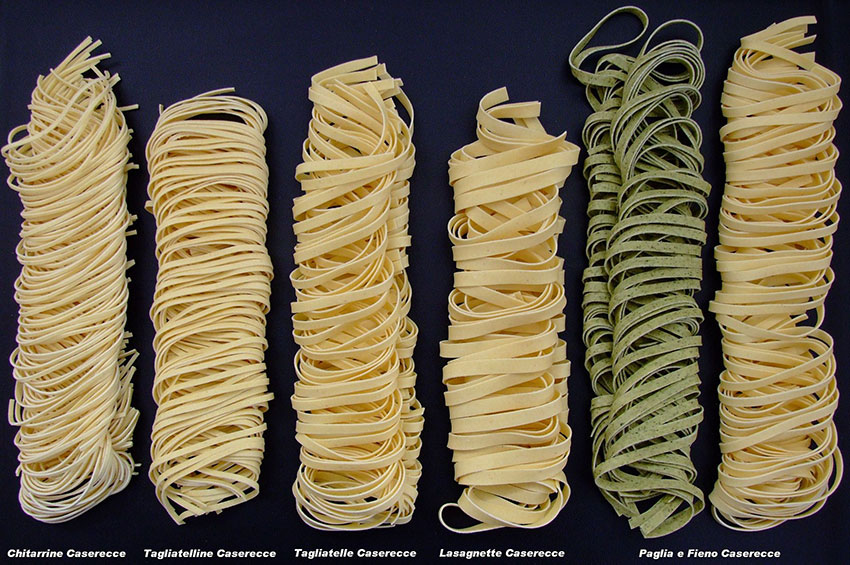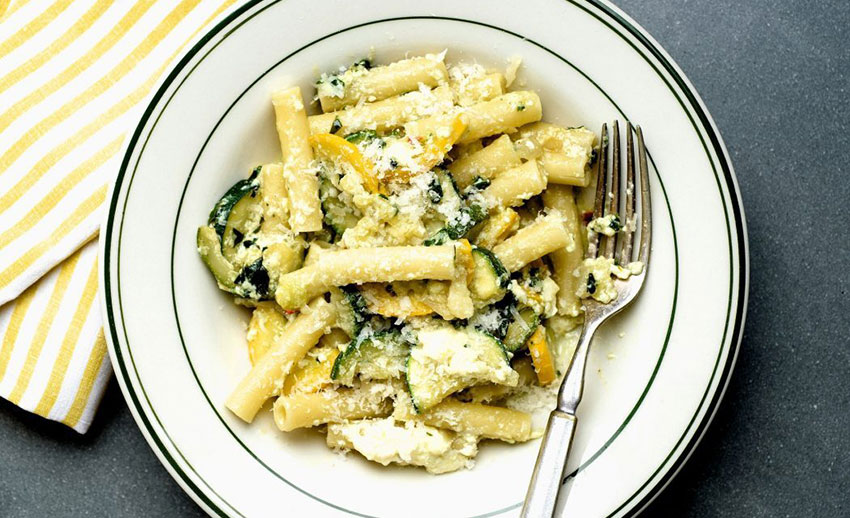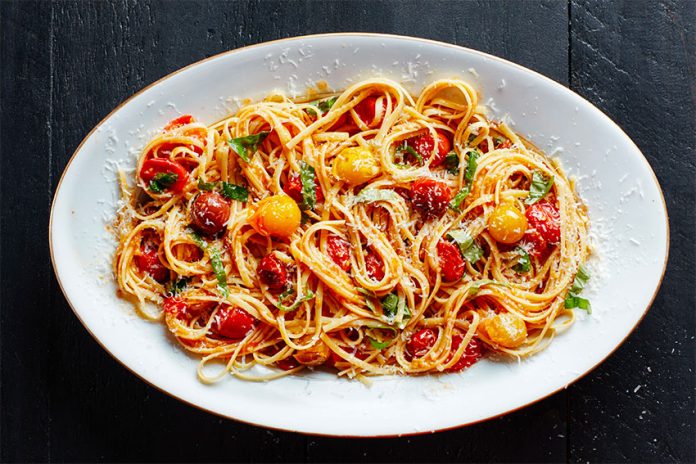While the hot summer weather makes me want to eat fruit, fruit and more fruit, I’ve also been craving pasta. But I mean pasta loaded with fresh veggies, a little exquisite cheese, some snipped green herbs, and cooked al dente so the flavors can really shine.
The pasta is just a vehicle for everything else. Served with a big salad, that’s a lovely summer meal in my book.
I tend to prefer thin spaghetti or capellini, and even with lasagna I look for the thinnest noodles I can find. That way I can have my pasta fix but not feel carb-overloaded. Scientifically speaking, cooked pasta’s composition is more than half water (62%, to be exact), but it sure feels like more than the 31% carbs they say it is.
The history of pasta is a long one, and probably doesn’t include Marco Polo bringing it over from China. (That legend most likely was a marketing campaign for a Canadian pasta company.) Historians say pasta was eaten in ancient Italy and Greece, beginning in the 13th century, although references to pasta-like foods have been found as far back as the first century AD. But it wasn’t until the 17th century that pasta was eaten with tomato sauce — prior to then, it had always been eaten dry or deep-fried as a finger-food.
The first pasta factory was licensed in Venice in 1740. And in the 14th and 15th centuries, dry pasta became a staple on long voyages because of its easy storage, thus bringing it to the New World and all of us on this side of the Atlantic.

The wide variety of pasta shapes have a reason; each works best with specific types of sauce and ingredients. So while it’s fine to use whatever you want, do consider this when you’re trying out a new recipe.
Noodles with holes (penne, bucatini, ziti) are best paired with more runny sauces, so they can be filled inside as well as coated on the outside; more “complex” pasta shapes, like rotini, farfalle and fusilli, are good for more oily, sticky sauces, like pestos, that will cling to the twists and turns. (Although linguini and other long, flat noodles provide ample space for these sauces to cling to as well.)
In any recipe, remember that fresh pastas won’t expand when cooked, so if you throw two cups into the water that’s what you’ll end up with. Dry pastas, out of a package, will double in size.
Cappellini with Roasted Cherry Tomatoes
Slow-roasting the tomatoes brings out their natural sugars, resulting in a richer flavor than if they were sautéed.
- 1 pint box cherry tomatoes
- 1 Tbsp. extra-virgin olive oil (approximately)
- 1 Tbsp. butter, unsalted if possible
- Salt & freshly ground black pepper
- ½ lb. capellini
Preheat oven to 275 F. Cut cherry tomatoes in half and arrange cut-side up in baking pan or shallow casserole dish. Drizzle with olive oil and sprinkle with salt and pepper. Bake for 30-40 minutes, till tomatoes are soft but not mushy and juices have released. While they’re roasting, bring a pot of salted water to a boil and cook capellini, timing it so tomatoes and pasta are done at about the same time. Drain pasta; toss quickly with butter and a drizzle of olive oil, and then add tomatoes and juices. Top with Parmesan and a grate of pepper. Serve immediately.

Summer Pasta Verde
- Extra-virgin olive oil
- 1 small onion, finely diced
- 2 lbs. zucchini, cut in small cubes
- Salt and pepper
- 2-4 garlic cloves, minced
- About 2 cups fresh basil leaves
- 1 lb. ziti
- About 1 cup queso fresco or ricotta
- Pinch of crushed red pepper
- Zest of 1 lemon
- 1 cup freshly grated Parmesan cheese
In a large skillet over medium heat, cook onions in 3 Tbsp. olive oil until softened, 5-8 minutes. Add zucchini, season with salt and pepper, and continue cooking, stirring occasionally, about 10 minutes. Turn off heat.
Use a mortar and pestle to pound garlic, basil and a little salt into a rough paste (or use a mini-food processor). Stir in 3 Tbsp. olive oil.
Cook pasta until al dente; drain and reserve 1 cup of cooking water. Add cooked pasta to zucchini in skillet and heat on medium-high. Add ½ cup cooking water, then the queso fresco, red pepper and zest, stirring gently. Cook for 1 minute. Mixture should look creamy. Add a little more pasta water if necessary. Add basil paste and half the grated cheese and quickly stir to incorporate. Spoon pasta onto plates and sprinkle with additional cheese. Serve immediately. –nytimes.com
Pasta al Limone
A simple, beautiful dish. If you like, add julienned spinach, chard or green beans at the end.
- 1 lemon
- 12 oz. spaghetti or other long pasta
- Kosher salt
- ¾ cup heavy cream
- 6 Tbsp. unsalted butter
- 3 oz. finely grated Parmesan (about ¾ cup)
- Freshly ground black pepper
Using a vegetable peeler, remove two, 2-inch long strips of lemon zest. Thinly slice each strip lengthwise into thin strands; set aside for garnish. Finely grate remaining zest into a large pot. Cut lemon in half and squeeze out 2 Tbsp. juice into a small bowl; set aside. Cook pasta al dente in another large pot. Drain. Reserve 1½ cups cooking water.
Meanwhile, add cream to pot with lemon zest and cook over medium heat, whisking often, until liquid is just beginning to simmer, about 2 minutes. Reduce heat to medium-low. Whisk in butter 1 Tbsp. at a time until melted and sauce is creamy and emulsified. Remove from heat.
Add ¾ cup of cooking water to cream sauce and return to medium heat. Transfer spaghetti to pot with sauce. Cook, tossing often and adding Parmesan little by little, until cheese is melted and sauce is creamy, about 3 minutes. If sauce looks too thick, add 1–2 Tbsp. more cooking water. Stir in reserved lemon juice; season with more salt, if needed. Serve and garnish with reserved zest strips. -bonappetit.com
Janet Blaser has been a writer, editor and storyteller her entire life and feels fortunate to be able to write about great food, amazing places, fascinating people and unique events. Her first book, Why We Left: An Anthology of American Women Expats, is available on Amazon. Contact Janet or read her blog at whyweleftamerica.com.
